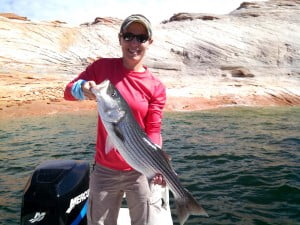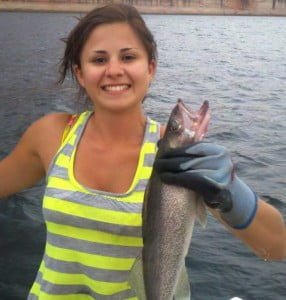Photo: Briann Reeves, caught a 9-pound striped bass fishing with bait in the main channel near Buoy 3. Bait fishing is still working lake wide for striped bass while walleye and bass fishing success is steadily improving each day.
Lake Elevation: 3583 Water Temperature 62-65 F
Lake Powell is rising. The lake looks refreshed as water is now covering vegetation that has grown along the shoreline. The rejuvenation is needed as low water over the past two years has changed how fish do business. Largemouth bass and crappie need brush to protect newly hatched fry but also to provide housing for adult fish unaccustomed to traveling the bank to find food. If bass need to search the shoreline for food, they often spend more energy searching than that provided by food that is found. The end result is the loss of excess fish that are two numerous for the food supply that is available. But this is a new day with increasing water levels and temperatures. Now shad are spawning to provide food needed for survival and brush is being covered to provide shelter. Good times are here for the enjoyment of Lake Powell fish.
Fishing success is improving with warming water. Smallmouth bass are moving up onto open water reefs and can be caught on plastic baits or crankbaits fished on top of the reefs. Larger fish are in deeper water near the breaking edge of reefs where small fish are found. Walleye are caught in the backs of canyons and coves with plastic grubs fished slowly along the bottom. Live worms are an added enticement when added to the jig or used specifically on a bottom bouncer and worm harness. Walleye catch is increasing lake wide but walleye numbers are much greater in the northern lake than the southern. Look for wind induced mud lines near long points dropping into deep water. Murky to muddy water coves are great walleye spots in the month of May.
Striped bass have been indirectly impacted by the loss of brush which has resulted in less forage being available. The impact is more noticeable in the southern lake where forage is scarce than near the inflow where more shad survived the winter. Juvenile striped bass are feeding on plankton which is available near the surface in many open water locations. Trolling is the best technique to find the randomly scattered stripers that are consistently found in the backs of most canyons where water depth is near 25 feet and water color is murky. While trolling, watch the graph for fish concentrations. I throw a floating marker where fish traces are most dense. Usually trolling with Shad Raps or Pointers will be steady for a time. When a fish is caught trolling, cast lures or drop spoons in the area to catch trailing stripers. Finally, when trolling and spooning quit producing return to the marker, chum with anchovies and catch more fish from the same area. This multipurpose fishing process is quite effective and will provide good numbers of stripers at the end of the day.
Striper schools are moving from cove to cove searching for food. They may be in one spot today and a mile away the next. The prime spot is at the 25 foot mark in the backs of canyons but they can also now be found in many coves along the main channel. In open water they will be found schooled along the 25 foot contour where the bottom drops quickly to deeper water. Again troll the contour, mark the school, and return to spoon or fish bait where fish are marked. Good striper catching spots the past week include the dam half way from the barricade to buoy one, the first point past the double island in Navajo Canyon, Padre Canyon, Last Chance, the Rock Creek canyons, and Wetherill. Midlake reports are best near Moki canyon for those using bait. The mudline is at the lower end of Good Hope bay and water color has drifted all the way to Bullfrog. Perhaps the best spot for stripers this week is in the Escalante Arm. Try a wide variety of locations and techniques to locate the most successful combination on each fishing day.





